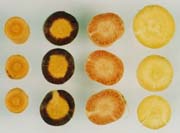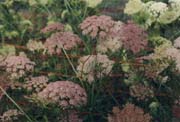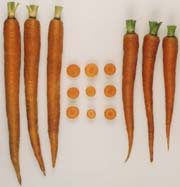| Simon: Pubs: 97hort0012 |

|
Cover Page with Article
Published in HortScience 32(1):12-13. 1997
Plant Pigments for Color and Nutrition
Vegetable Crops Research Unit, Agricultural Research Service, U.S. Department of Agriculture, Department of Horticulture, University of Wisconsin, Madison, WI 53706
Received for publication 13 Nov. 1995. Accepted for publication 26 May 1996.
Cover Illustrations
The pigments found in plants play important roles in plant metabolism and visual attraction in nature (Goodwin, 1976, 1988; Gross, 1987, 1991; Kost, 1988). are also important for humans, attracting our attention and providing us with nutrients. Major plant pigments include carotenoids, anthocyanins and other flavonoids, betalains, and chlorophylls.
Chlorophylls, which are green, and carotenoids, which are yellow, orange or red, play pivotal roles in photosynthesis (Bauernfeind, 1981; Dailey, 1990; Young and Britton, 1993). They occur in all green plants and are localized in plastids. Chlorophylls capture light energy and convert it into chemical energy. They rarely occur outside of photosynthetic tissue. Carotenoids protect the chlorophylls from photo-oxidation and are accessory, light-harvesting pigments and photoreceptors. They occur in all green tissues as well as independently of chlorophyll in flowers (where they serve to attract animals), storage organs, and other plant parts.
Flavonoids include red or blue anthocyanins and white or pale yellow compounds such as rutin, quercitin, and kaempferol (Mazza and Miniati, 1993; Stafford, 1990). Flavonoids in flowers and fruit provide visual cues for animal pollinators and seed dispersers to locate their target. They also occur in most other plant parts and in most genera. Flavonoids are located in the cytoplasm and plastids. Like carotenoids and flavonoids in flowers and fruit, betalains also are likely to play an important role in attracting animals (Clement et al., 1994). These red-violet (betacyanin) and yellow (betaxanthin) pigments, which are located in the cytoplasm of plant tissue, only occur in about 10 plant families (and always independent of anthocyanins).
Plant pigments are important cues to humans and other herbivorous animals in helping identify plants, find plant parts such as fruit, leaves, stems, roots, or tubers, and determine stages of plant development such as fruit ripeness or overall senescence. It was realized early in this century that many of these pigments play a positive role in human health. In 1919, Steenbock noted that yellow corn (Zea mays L.) and "yellow" vegetables (carrots (Daucus carota L.) and sweetpotato (Ipomoea batatas L.)) eliminated the symptoms of vitamin A deficiency in rats while white corn and "white" vegetables (parsnip (Pastinoca sativa L.), potato (Solanum tuberosum L.), and beets (Beta vulgaris L.) did not (Steenbock, 1919; Steenbock and Gross, 1919). Since then, approximately 40 carotenoids have been found to be vitamin A precursors (Simpson, 1983). When provitamin A carotenoids are consumed, they are enzymatically broken down to retinol (vitamin A). In this way, consumption of horticultural crops provides over 80% of the vitamin A for the world (Simon, 1990). Vitamin A deficiency worldwide is the most common specific dietary deficiency as it afflicts millions of children each year with xerophthalmia, blindness, or death. Subclinical deficiency also reduces immune function to increase the risk of severe and fatal infections (Underwood, 1994). Therefore, the development of new and more potent sources of provitamin A carotenoids in horticultural crops, and improvement of production, shelf life and consumer acceptance of these crops can make an important contribution to improved human health.
Research findings since the 1970s have indicated that food crops containing carotenoids, anthocyanins, and other flavonoids are believed to function as "chemopreventers", by providing protection against certain forms of cancer and a reduction of cardiovascular disease (Stavric, 1994). Interestingly, non-provitamin A carotenoids such as lycopene, the major pigment of tomato (Lycopersicon esculentum L. and watermelon (Citrullus lanatus Thunb.), also confer chemoprevention. The important characteristic common to all chemopreventers is their antioxidant capacity. The antioxidant properties of carotenoids which protect plants in photosynthesis apparently may also protect humans from carcinogens and heart disease. Plant pigments are only a subset of the naturally occurring chemopreventers in vegetables and fruits. Other chemopreventive antioxidants in plants include vitamin C, vitamin E, phenolic acids, and organosulfur compounds.
While many clinical trials supplementing the diet with individual antioxidants have been successful in reducing health risks, some trials have not, for reasons yet unclear (Blumberg and Block, 1994; Hennekens, 1994). Because of the complexity of large scale efficacy testing of natural compounds in foods, dietary supplementation with plant pigments and other chemopreventers has not yet been undertaken. However increased intake of the best sources of these compounds - fruits and vegetables - is encouraged (Block and Langseth, 1994; Dwyer, 1995; Willett, 1994).
Horticulturists have long studied plant pigments in vegetables, fruits and ornamental crops because of their vital role in visual appeal. More recently efforts have included nutritional evaluation and improvement of food crops as a source of vitamins. Munger (1988) listed the orange and red vegetables (carrot, sweetpotato, and tomato) as major sources of provitamin A carotenoids. Compared to typical carrots, sweetpotatoes, and tomatoes which contain 160, 120, and 7 mg.kg-1 (fresh weight) of provitamin A carotenoids, respectively, high-carotene genetic sources containing 600, 170, and 95 mg.kg-1, respectively, have been bred (Simon, 1990, 1992; Simon et al., 1989; also see cover). Even typically low-carotene vegetables, such as cauliflower (Brassica oleracea) (Dickson et al., 1988) and cucumber (Cucumis sativus L.) (Simon and Navazio, 1997; see cover) can be genetically improved to serve as a source of carotenoids.
With the increasing evidence of the positive influence of plant pigments on human health, a heightened interest in a broad range of vegetable pigments and chemopreventers is developing. Genetic improvement of anthocyanin or betalain content has been successful for a variety of vegetables (De Jong, 1991; El-Shafie and Davis, 1967; Miyazaki et al., 1991; Wolyn and Gabelman, 1990; also see cover and Simon et al., 1997). Chemical and biotechnological approaches to improvement of plant pigments are also encouraging (Farag and Palta, 1992; Gutterson, 1995).
Horticultural approaches for improving the nutritional quality and visual appeal of our food supply provide a sustainable, inexpensive complement to medical and social programs for preventing human disease. Plant pigments provide a common interface familiar to horticultural researchers, medical researchers, students, producers, marketers, and consumers. Discussions at this interface will relate the relevance of science, in general, and horticulture, in particular, to the general public and can stimulate student interest.
Literature Cited
Bauernfeind, J.C. (ed.). 1981. Carotenoids as colorants and vitamin A precursors. Academic Press, New York.
Block, G. and L. Langseth. 1994. Antioxidant vitamins and disease prevention. Food Tech. 48:80-84.
Blumberg, J. and G. Block. 1994. The alpha-tocopherol, beta-carotene cancer preventing study in Finland. Nutr. Rev. 52:242-245.
Clement, J.S., T.J. Mabry, H. Wyler, A.S. Dreiding. 1994. Chemical review and evolutionary significance of the betalains. In: H.D. Behnke and T.J. Mabry (eds.). Caryophyllales: evolution and systematics. Springer Verlag. Pp. 247-261.
Dailey, H.A. 1990. Biosynthesis of heme and chlorophylls. McGraw-Hill, New York.
De Jong, H. 1991. Inheritance of anthocyanin pigmentation in the cultivated potato: a critical review. Am. Potato J. 68:585-591.
Dickson, M.H., C.Y. Lee and A.E. Bramble. 1988. Orange-curd high carotene cauliflower inbreds, NY156, NY163, and NY165. HortScience 23:778-779.
Dwyer, J. 1995. Overview: dietary approaches for reducing cardiovascular disease risks. J. Nutr. 125:656S-665S.
El-Shafie, M.W.A. and G.N. Davis. 1967. Inheritance of bulb color in the onion (Allium cepa L.). Hilgardia 38:607-622.
Farag, K.M. and J.P. Palta. 1992. Ethanol enhances the effectiveness of ethephon on anthocyanin production in cranberry fruit in the field. HortScience 27:411-412.
Goodwin, T.W. (ed.). 1976. Chemistry and biochemistry of plant pigments. Academic Press, London.
Goodwin, T.W. (ed.). 1988. Plant pigments. Academic Press, London.
Gross, J. 1987. Pigments in fruits. Academic Press, London.
Gross, J. 1991. Pigments in vegetables: chlorophylls and carotenoids. Van Nostrand Reinhold, New York.
Gutterson, N. 1995. Anthocyanin biosynthetic genes and their application to flower color modification through sense suppression. HortScience 30:964-966.
Hennekens, C.H. 1994. Antioxidant vitamins and cancer. Amer. J. Medicine 97 (3A): 2s-4s.
Kost, H.-P. 1988. Plant pigments. CRC Press, Boca Raton, FL.
Mazza, G. and E. Miniati. 1993. Anthocyanins in fruits, vegetables, and grains. CRC Press, Boca Raton, FL.
Miyazaki, T., W. Tsuzuki and T. Suzuki. 1991. Composition and structure of anthocyanins in the periderm and flesh of sweet potatoes. J. Jpn. Soc. Hortic. Sci. 60:217-220.
Munger, H. 1988. Adaptation and breeding of vegetable crops for improved human nutrition, pp 177-184. In: B. Quebedeaux and F.A. Bliss (eds.), Horticulture and human health. Prentice Hall, Englewood Cliffs, NJ.
Simon, P.W. 1990. Carrots and other horticultural crops as a source of provitamin A carotenes. HortScience 25:1495-1499.
Simon, P.W. 1992. Genetic improvement of vegetable carotene content, p. 291-300. In: D.D. Bills and S.-D. Kung (eds.). Biotechnology and Nutrition, Proc. 3rd Intl. Symp. Butterworth-Heinemann. Boston, MA.
Simon, P.W., V.E. Rubatzky, M.J. Bassett, J.O. Strandberg, and J.M. White. 1997. B7262 purple carrot inbred. HortScience 32: 146-147.
Simon, P.W. and J.P. Navazio. 1997. Early Orange Mass 400, Early Orange Mass 402, and Late Orange Mass 404: High-Carotene Cucumber Germplasm. HortScience 32: 144-145.
Simon, P.W., X.Y. Wolff, C.E. Peterson, D.S. Kammerlohr, V.E. Rubatzky, J.O. Strandberg, M.J. Bassett, and J.M. White. 1989. High Carotene Mass Carrot Population. HortScience 24: 174.
Simpson, K.L. 1983. Relative value of carotenoids as precursors of vitamin A. Proc. Nutr. Soc. 42:7-17.
Stafford, H.A. 1990. Flavonoid metabolism. CRC Press, Boca Raton, FL.
Stavric, B. 1994. Role of chemopreventers in human diet. Clin. Biochem. 27:319- 332.
Steenbock, H. 1919. White corn vs. yellow corn and a probable relation between the fat-soluble vitamine and yellow plant pigments. Science 50:352-353.
Steenbock, H. and E.G. Gross. 1919. Fat-soluble vitamine. II. The fat-soluble vitamine content of roots, together with some observations on their water-soluble vitamine content. J. Biol. Chem. 40:501-531.
Underwood, B.A. 1994. Hypovitaminosis A: international programmatic issues. J.Nutr. 124:1467S-1472S.
Willett, W.C. 1994. Micronutrients and cancer risks. Am. J. Clin. Nutr. 59: 1162S- 1165S.
Wolyn, D.J. and W.H. Gabelman. 1990. Selection for betalain pigment concentrations and total dissolved solids in red table beets. J. Amer. Soc. Hort. Sci. 115:165-169.
Young, A. and G. Britton (eds.). 1993. Carotenoids in photosynthesis. Chapman & Hall, London.





